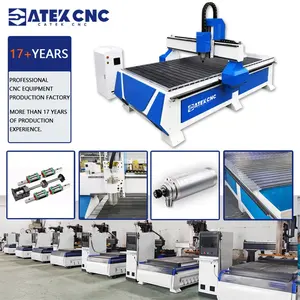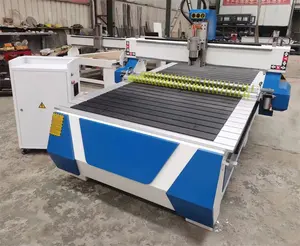Types of desktop CNC routers with CE
A desktop CNC router with CE is a Compact desktop CNC machine that can automatically carve and engrave materials, including wood, PVC, seals, etc. Generally, There are ten main kinds of CNC routers made for desktops or as a table-topped, Compact, and useful device for carving designs into a workpiece and providing relief carving, engraving, and cutting. These include the CNC wood router, CNC milling machine, CNC foam cutter, CNC stone engraving machine, CNC acrylic cutter, Laser CNC router, Plasma CNC router, CNC metal router, CNC fiber machine, and mixed-use desktop CNC machine.
- CNC Wood Router: A desktop wood CNC router is a type of carving machine that operates by using Computer-aided design and computer-aided manufacturing to carve a decorative pattern on the top of the furniture or for creating ornamental patterns on the furniture. It is used primarily for wood and includes easily operated software.
- CNC Milling Machine: The main difference between a desktop CNC router and a CNC milling machine lies in the materials they are designed to work with and their capabilities. While a desktop CNC router is ideal for softer materials like wood, foam, or plastic, a CNC milling machine is suitable for harder materials such as metal, aluminum, and brass. CNC milling machines are designed to handle tougher jobs and are more massive than CNC routers; thus, they can deal with hard materials. Moreover, a CNC milling machine has a spindle that can rotate at higher speeds than that of a desktop CNC router machine.
- CNC Foam Cutter: A foam cutter works in the same way as a router does, by cutting the material based on the CNC design. The main difference between a desktop CNC foam cutter and a CNC router is that the material being worked on is different. While a foam cutter will typically work on Styrofoam and EPS, the CNC router can cut through wood, PVC, acrylic, and other similar materials.
- CNC Stone Engraving Machine: The desktop stone engraving CNC machine is mainly a micro device for carving stone more precisely and accurately. These machines offer ideal design possibilities to engrave difficult patterns or models on stones such as marble, granite, and others with perfection.
- CNC Acrylic Cutter: The ACS (Acrylic Cutting Service) is available to enable you to use your desktop CNC device to manufacture a variet yof acrylic sheets, such as the spectacular ROSE GOLD mirror face and the charming crystalline issue. This permits you to make an entirely customized product with whatever type face you want.
- Laser CNC Router: This type uses a laser to cut or engrave materials, providing high precision and detail. Laser power can vary, affecting cutting speed and depth.
- Plasma CNC Router: This type uses plasma arcs to cut metals. It's commonly used for sheet metal cutting and provides clean cuts with minimal waste.
- Cnc Metal Router: This machine is designed specifically for cutting through metals like aluminum and steel. A metal router is more massive, and its motor is stronger so that hard materials can be cut through precisely. Furthermore, its cutting bits and blades are tough enough to last longer and cut through metal materials accurately.
- CNC Fiber Machine: operates the same way as a CNC machine does, by using Computer-Aided Design and Computer-Aided Manufacturing to cut its material and mold it in a specific way without effort and precision. The main difference between a fiber machine and a CNC machine is the material that is being cut through.
- Mixed-Use Desktop CNC Machine: The desktop mixed-use CNC machine is a 3D version of a worktop device that can be used for all desktop models. This central device will come with other accessories that are needed for other processes, such as laser engraving, and will be able to accomplish more tasks through its very simple change of tools model.
Specifications & Maintenance
Specifications will vary based on the item and manufacturer when it comes to a 3D CNC router desktop with CE. The following are some general specifications that will commonly be found.
- Working area: The working area can range from small areas (around 50x50x50 cm) to larger ones (150x150x150 cm). This will depend on the size of the router itself.
- Materials supported: A desktop CNC machine will usually support various soft materials, including wood, plastic, foam, and rubber. However, harder materials like metal, ceramic, and glass may only work with specific models designed to handle them.
- File formats: Desktop CNC routers work with various files produced by CAD programs. Typically, the most common file format for a CNC router is DXF. Other examples include DWG and PLT.
- Vacuum pump power: Models can differ from a 1000w to a 3000w.
- Voltage and current: Most models have a current of around 6A and operate under a voltage of 110/220V.
Maintenance
A desktop CNC machine does not require a lot of maintenance. However, because it is an intricate and fragile machine, it is essential to do the following:
- Regularly inspect components: Make sure to scan the machine for any signs of damage, abnormal wear or tear, or looseness that may impede the router's functioning. Pay close attention to parts like the spindles, belts, gantry, cutting tool, and linoleum bearings, to name a few.
- Lubrication of moving parts: Normally, grease or oil is used to keep the moving parts working and functioning smoothly. This is essential to keep the CNC router desktop machine functioning for many years to come.
- Cleaning: Dust and debris can build up fast on a CNC router machine. This can eventually affect the little parts of the router, like the motors and rails. It is advised to clean the machine often, as dust build-up can shorten its lifecycle.
Applications of desktop CNC router with CE
Users of a desktop CNC machine have a variety of applications for it. Due to their small sizes, these machines are perfect for use in workshops, makerspaces, and schools. They are employed for woodworking jobs like cutting, carving, and engraving logos, designs, and texts on furniture, doors, and other wood items. They do this with a level of customization that is unmatched by hand tools.
Another typical use case is the production of prototypes. Small parts and prototypes are manufactured using desktop CNC machines in low-volume manufacturing or pre-manufacturing.
Apart from this, educational institutions employ the routers to instruct woodwork and design students on how to use CNC technology. The machines are simple to use, and students will learn how to create digital designs for automatic carving and routing.
Jewelers and artisans use the compact CNC machines to engrave and carve small objects made of metal, plastic, or acrylic. The precision of these mini-routers allows for intricate work on items like jewelry pieces, nameplates, and customized gadgets and components.
Sign makers can easily create different types of signage using the CNC desktop router. These include guidance signs, storefront signs, parameter signs, etc. The router can cut, engrave, and shape materials like plastic, metal, and wood to create complex and clear signs. Thanks to their low prices, these machines are also affordable in cost and easy to use, making them ideal for novice sign designers and hobbyists.
How to choose desktop CNC router with CE
Considering the following factors when purchasing a desktop CNC Router with CE will help consumers select the most appropriate machine for their requirements.
- Capability and capacity: Identify the sort of materials that will be worked with the router in a particular application. Is it wood, plastic, rubber, leather, or foam? After that, make sure the desktop CNC Router can work with those materials and has the capabilities and capacity to do so.
- Spindle: The desktop CNC Router's spindle determines how it cuts materials and the quality of the final output. Select a router with spindles that can handle various cutting requirements.
- Software: The kind of software that a CNC machine uses can significantly impact its capabilities and compatibility with other systems. Make sure the software used by the router for design and control is simple to use and works with the design files that will be utilized.
- Power: Make sure the power rating of the desktop CNC Router is sufficient for the materials and cutting tasks that will be performed.
- Vacuum Table: A vacuum table is used to hold down materials to be cut by a CNC router. Evaluate the vacuum table included with the router or consider purchasing a separate one. Check to see if the tabletop can firmly hold items and is large enough for the required workpieces.
- Warranty and afterservice: Select a provider who offers comprehensive post-purchase support to ensure that they will get the necessary assistance when needed. A desktop CNC router user will feel more confident in their investment if they have the protection of a strong warranty and good customer support service.
Desktop CNC router with CE Q&A
Q: What materials can a desktop CNC router work with?
A: Desktop CNC routers are primarily designed to cut, carve, engrave, and mill softwood, hardwood, other wood composites, plastic, and aluminum. More powerful routers and models with stronger spindles can also work with other types of metal, including copper and brass.
Q: Does a desktop CNC router come with software?
A: Usually, yes. The software is typically compatible with Windows. However, the type and features may vary depending on the manufacturer. Some models may also support offline control, while buyers will need to upload commands and files to others.
Q: Are CNC routers expensive?
A: The price varies depending on the size (desktop vs. full-size), functionality (2D vs. 2D/3D), strength of the spindle and motors, cutting accuracy, latest technology features, and safety certifications, among other things. Generally speaking, a desktop model will cost less than a full-sized one.
Q: Is it easy to use a desktop CNC router?
A: With the latest technology and easy-to-use software, operating a desktop CNC router has become much easier. Something that used to take months or years to learn can now be mastered in a few hours or a few days at most.




























